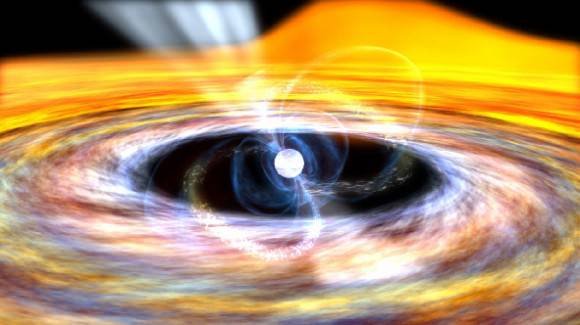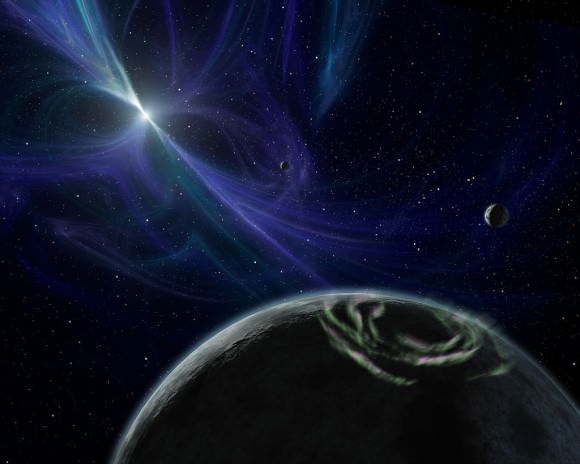They are what is known as the “lighthouses” of the universe – rotating neutron stars that emit a focused beam of electromagnetic radiation that is only visible if you’re standing in it’s path. Known as pulsars, these stellar relics get their name because of the way their emissions appear to be “pulsating” out into space.
Not only are these ancient stellar objects very fascinating and awesome to behold, they are very useful to astronomers as well. This is due to the fact that they have regular rotational periods, which produces a very precise internal in its pulses – ranging from milliseconds to seconds.
Description:
Pulsars are types of neutron stars; the dead relics of massive stars. What sets pulsars apart from regular neutron stars is that they’re highly magnetized, and rotating at enormous speeds. Astronomers detect them by the radio pulses they emit at regular intervals.

Formation:
The formation of a pulsar is very similar to the creation of a neutron star. When a massive star with 4 to 8 times the mass of our Sun dies, it detonates as a supernova. The outer layers are blasted off into space, and the inner core contracts down with its gravity. The gravitational pressure is so strong that it overcomes the bonds that keep atoms apart.
Electrons and protons are crushed together by gravity to form neutrons. The gravity on the surface of a neutron star is about 2 x 1011 the force of gravity on Earth. So, the most massive stars detonate as supernovae, and can explode or collapse into black holes. If they’re less massive, like our Sun, they blast away their outer layers and then slowly cool down as white dwarfs.
But for stars between 1.4 and 3.2 times the mass of the Sun, they may still become supernovae, but they just don’t have enough mass to make a black hole. These medium mass objects end their lives as neutron stars, and some of these can become pulsars or magnetars. When these stars collapse, they maintain their angular momentum.
But with a much smaller size, their rotational speed increases dramatically, spinning many times a second. This relatively tiny, super dense object, emits a powerful blast of radiation along its magnetic field lines, although this beam of radiation doesn’t necessarily line up with it’s axis of rotation. So, pulsars are simply rotating neutron stars.
And so, from here on Earth, when astronomers detect an intense beam of radio emissions several times a second, as it rotates around like a lighthouse beam – this is a pulsar.
History:
The first pulsar was discovered in 1967 by Jocelyn Bell Burnell and Antony Hewis, and it surprised the scientific community by the regular radio emissions it transmitted. They detected a mysterious radio emission coming from a fixed point in the sky that peaked every 1.33 seconds. These emissions were so regular that some astronomers thought it might be evidence of communications from an intelligent civilization.
Although Burnell and Hewis were certain it had a natural origin, they named it LGM-1, which stands for “little green men”, and subsequent discoveries have helped astronomers discover the true nature of these strange objects.
Astronomers theorized that they were rapidly rotating neutron stars, and this was further supported by the discovery of a pulsar with a very short period (33-millisecond) in the Crab nebula. There have been a total of 1600 found so far, and the fastest discovered emits 716 pulses a second.
Later on, pulsars were found in binary systems, which helped to confirm Einstein’s theory of general relativity. And in 1982, a pulsar was found with a rotation period of just 1.6 microseconds. In fact, the first extrasolar planets ever discovered were found orbiting a pulsar – of course, it wouldn’t be a very habitable place.
Interesting Facts:
When a pulsar first forms, it has the most energy and fastest rotational speed. As it releases electromagnetic power through its beams, it gradually slows down. Within 10 to 100 million years, it slows to the point that its beams shut off and the pulsar becomes quiet.
When they are active, they spin with such uncanny regularity that they’re used as timers by astronomers. In fact, it is said that certain types of pulsars rival atomic clocks in their accuracy in keeping time.
Pulsars also help us search for gravitational waves, probe the interstellar medium, and even find extrasolar planets in orbit. In fact, the first extrasolar planets were discovered around a pulsar in 1992, when astronomers Aleksander Wolszczan and Dale Frail announced the discovery of a multi-planet planetary system around PSR B1257+12 – a millisecond pulsar now known to have two extrasolar planets.

It has even been proposed that spacecraft could use them as beacons to help navigate around the Solar System. On NASA’s Voyager spacecraft, there are maps that show the direction of the Sun to 14 pulsars in our region. If aliens wanted to find our home planet, they couldn’t ask for a more accurate map.
We have written many articles about stars here on Universe Today. Here’s an article about a newly discovered gamma ray pulsar, and here’s an article about how millisecond pulsars spin so fast.
If you’d like more information on stars, check out Hubblesite’s News Releases about Stars, and here’s the stars and galaxies homepage.
We have recorded several episodes of Astronomy Cast about stars. Here are two that you might find helpful: Episode 12: Where Do Baby Stars Come From, and Episode 13: Where Do Stars Go When they Die?


It’s been hypothesized before that pulsars could be utilized by ET civilizations to communicate over vast distances in the galaxy. A recent paper explored the possibility of modulating pulsars through the construction of Dyson shells around them: http://arxiv.org/abs/1311.4608
“But for stars between 1.4 and 3.2 times the mass of the Sun, they may
still become supernovae, but they just don’t have enough mass to make a
black hole.”
I believe this is the mass of the remnant, not of the original star.
1.6 microseconds? Shouldn’t it be either 1600 microseconds or 1.6 milliseconds?